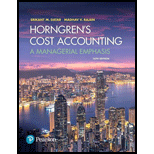
Alternative methods of joint-cost allocation, ending inventories. The Cook Company operates a simple chemical process to convert a single material into three separate items, referred to here as X, Y, and Z. All three end products are separated simultaneously at a single splitoff point.
Products X and Y are ready for sale immediately upon splitoff without further processing or any other additional costs. Product Z, however, is processed further before being sold. There is no available market price for Z at the splitoff point.
The selling prices quoted here are expected to remain the same in the coming year. During 2017, the selling prices of the items and the total amounts sold were as follows:
- X—68 tons sold for $1,200 per ton
- Y—480 tons sold for $900 per ton
- Z—672 tons sold for $600 per ton
The total joint
There were no beginning inventories of X, Y, or Z. At the end of the year, the following inventories of completed units were on hand: X, 132 tons; Y, 120 tons; Z, 28 tons. There was no beginning or ending work in process.
- 1. Compute the cost of inventories of X, Y, and Z for balance sheet purposes and the cost of goods sold for income statement purposes as of December 31, 2017, using the following joint-cost-allocation methods:
Required
- a. NRV method
- b. Constant gross-margin percentage NRV method
- 2. Compare the gross-margin percentages for X, Y, and Z using the two methods given in requirement 1.
Learn your wayIncludes step-by-step video

Chapter 16 Solutions
Horngren's Cost Accounting: A Managerial Emphasis (16th Edition)
Additional Business Textbook Solutions
Horngren's Accounting (12th Edition)
FUNDAMENTALS OF CORPORATE FINANCE
Fundamentals of Management (10th Edition)
Principles of Operations Management: Sustainability and Supply Chain Management (10th Edition)
Gitman: Principl Manageri Finance_15 (15th Edition) (What's New in Finance)
Business Essentials (12th Edition) (What's New in Intro to Business)
- What is the companys CM ratio?arrow_forwardTutor provide answer pleasearrow_forwardIn a certain standard costing system, the following results occurred last period: total labor variance, 3200 F; labor efficiency variance, 4,300 F; and the actual labor rate was $0.35 more per hour than the standard labor rate. The number of direct labor hours used last period was __.arrow_forward
 Cornerstones of Cost Management (Cornerstones Ser...AccountingISBN:9781305970663Author:Don R. Hansen, Maryanne M. MowenPublisher:Cengage Learning
Cornerstones of Cost Management (Cornerstones Ser...AccountingISBN:9781305970663Author:Don R. Hansen, Maryanne M. MowenPublisher:Cengage Learning
